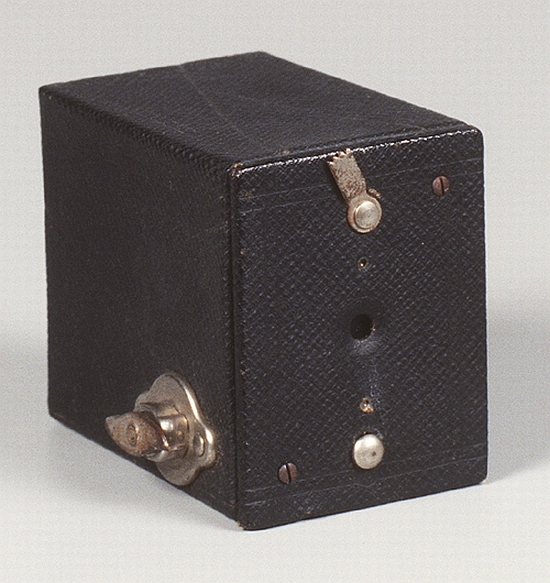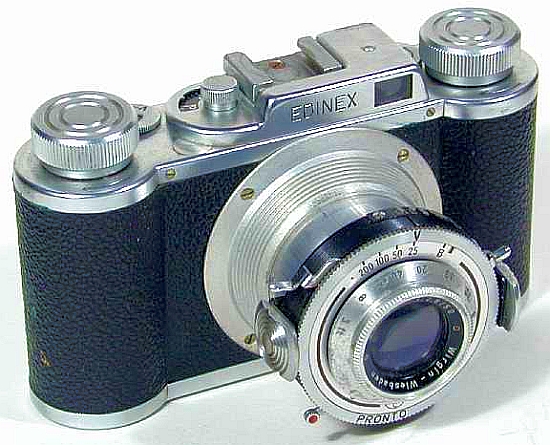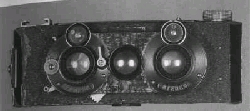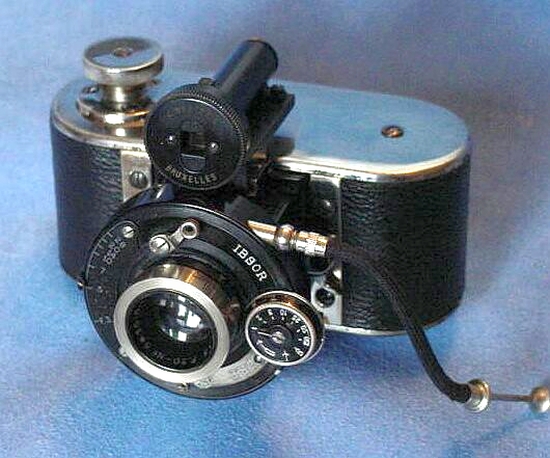| Produced |
Model |
Year |
Innovative characteristic |
Lense |
Picture |
| George P.Smith |
Smith |
1912 |
really rare US camera made in Missouri. First with 24×36 format. |
don’t know |
 |
| Herbert & Huesgen, New Ideas Mfg. Co. |
Tourist Multiple |
1913 |
Vertically styled body, leather covered, Tourist Multiple became the first commercially produced 35mm camera to be sold (although it had been on the market sometime toward the end of 1913), probably about 1000 cameras were ever made (McKeown, 1994). It contained a 50 foot magazine with enough film for 750 half frame exposures 18x24mm, shutter 40 – 200. There was also a multiple projector (film strip) available for $100.00. |
Zeiss Tessar Series Ic 1:3.5/50 or Goerz Hypar f3.5, or Steinheil Triplar f2.5. |
  |
| Jules Richard |
Homeos |
1914 |
the first 35mm camera was the “Homeos” (1913) a year before Oskar Barnack’s “UR” prototype. And it was 1925 before the first production Leica hit the market, fixed focus, diapphragm: f/4.5, f/6.3, f/8, f/10 e f/20 |
Krauss Tessar 1:4.5/28 |
 |
| Multi-Speed-New York |
Simplex |
1914 |
multi-exposure, multi-speed shutter Compound 00, 1/300, 800 exposures 18×24. The rarest pre-Leica and the most valuable today is the Simplex Multi-Exposure 35mm camera…. Five, possibly six are known. |
Tessar 1:3.5/50 |
 |
| Ernst Leitz |
UR Leica |
1914 |
Oskar Barnack works on the design of a camera for 35 mm motion picture film. The result materializes early in 1914 with the legendary “Ur LEICA”, vindicating the concept “small negative large pictures” |
|
 |
| Levy Roth |
Minnigraph |
1915 |
50 exposures 18×24 on 35mm film in special cassettes |
Anastigmat 1:3.5/54 |
 |
| Kodak |
00 Cartridge Premo |
1916 |
Six exposure roll film, 32×44 mm format box camera, the first in Kodak for little format. |
not know |
 |
| FACT |
Autocinephot |
1918 |
Original camera planned from Tartara and named Autocinephot, equipped with a spring motor and can carry out seven various functions, camera, cinema camera, floodlight, magnifier etc. The shutter like a cross of Malta said about however the main employment like cinema camera rather than as camera very soon the licence comes yielded the French manufacturer André Debrie who producted it with the Sept name. |
|
 |
| Hewit-Beaufort |
Hewit-Beaufort |
1921 |
On october 26, 1921, mr.Hewit and mr.Beaufort in London done a brevet (number 28.455) for a camera that used cine-film, with film advance and cocking shutter done to prevent double exposure (very similar to Tenax, adopted many years after by Zeiss), with the possibility to charge film in light by special cartridge. Format 23x31mm, central shutter from 1sec to 1/300, little reflex finder and after Albada-galileian, the project was abandoned after few years. |
Cook f3.1/50 |
 |
| Morsolin |
Argus |
1921 |
In the 1921 Francesco Morsolin introduces the Argus camera that employs 35mm perforated film and had an autonomy of about one hundred of format negatives 30x45mm. The camera comes constructed in a limited pieces number, perhaps only five hundred, but Paris camera maker Krauss produced e really similar camera: Eka ! |
Tessar 1:4.5/50, Koritska |
 |
| Victor Houssin |
Le Phototank |
1922 |
A strange project by french Henri Bayle, 50 exposure 18x24mm on 35mm. |
Berthiot Stellar 1:3.5/50 |
 |
| Dr. Rudolph |
Cosmos 35 |
1922 |
Dr. Rudolph’s Spezial-Kamera Cosmos 35, c. 1922 Green leathered metal camera, dimensions without lens and fittings 65 x 105 x 38 mm. Exceptionally important in several respects: 1) An early “Plasmat 2/35”, no. 251.373. The Plasmat was the “Kino-Plasmat” for 35 mm film, here in a testing camera for the whole 35 mm size. Slight corner vignetting visible. – 2) Dr. Rudolph as manufacturer. He left the Zeiss company already in 1920, not least because of differences of opinion about the Plasmat production. – 3) Very early German 35 mm camera. – 4) Very unusual shutter with 7 sec. delayed action! – 5) Fast lens. Lens speed of 1:2 was sensationally. – 6) Classic modern angular shaped camera design, with green leathering. – Worldwide the only known “Cosmos 35”. |
Plasmat 2/35 |
 |
| Steinheil |
Test Camera |
1922 |
Test Camera Steinheil. c. 1922 Extremely early camera for 35 mm. Wooden body, leathered, top plates of aluminium, inner brass body. Extremely fast Steinheil “Cassar 2,5/7,5 cm”, No. 288.433. No other Steinheil lens 2,5/7,5 cm is known! Ibsor shutter. With 2 optical viewfinders and screen focusing (without screen). One finder glass cracked. According to Dr. Loher a prototype. Top rarity! This is a competition product to “Minigraph”. |
Cassar 2,5/7,5 |
 |
| Matonox |
Night-Camera |
? |
Matonox Night-Camera by C.P. Goerz, Berlin English engravings, exceptional night camera, Goerz lens “Photomaton 2/3 in.”, no. 751.908. Ilex shutter. F-stops: 2; 2,5; 3; 3,5; 4,5. With “Prism Tele Viewfinder for Matonox Night-Camera III inch”. Camera and viewfinder with serial number 42, special lens hood as well (1042). Negative size 24 x 36 mm! With special case. Photomaton lens absolutely unknown! After the incorporation of Goerz into Zeiss Ikon in 1926 this development had not been continued! |
Goerz lens “Photomaton 2/3 |
 |
| Seischab |
Esco |
1922 |
Another early half-frame. Speeds from 1 – to 1/300. 400 17×24 pictures. 2 versions, with dial-set compur or with ring-set, like Leica Compur. |
Steinheil Anastigmat-Cassar 3,5/35 |
 |
| Werke Simons & Co. |
Sico |
1923 |
Dark brown wooden body with brass trim. The Sico takes number 25 30x40mm exposures on unperforated 35mm paper-backed rollfilm. Iris diaphram to f22. Dial Compur shutter 1-300. An unusual variation has leather-covered body, slightly larger in size, and different controls. |
Dagor f6.8 Double Anastigmat or Sico f3.5 Rüdersdorf Anastigmat |
 |
| Werke Simons & Co. |
Sico 2 |
1923 |
Like the Sico but leather covered and with a little different design, Compur shutter 1-300. |
Dagor f6.8 Double Anastigmat or Sico f3.5 Rüdersdorf Anastigmat |
 |
| E. Guérin & Cie. |
Furet Camera ver.1 |
1923 |
Small, early 35mm camera for 25 exposures 24 x 36mm using special cassettes. This is the smallest of the pre-Leica 0 35mm cameras. |
Hermagis Anastigmat 1:4.5/40 |
 |
| Debrie |
Sept Camera |
1923 |
Spring driven motor camera for still pictures, sequential pictures or movies. When a circular lid was removed from the back, the camera could be placed in front of a light source and act as a movie projector. 18x24mm on 35mm in special 5m cartridges. |
Roussel Stylor f3.5/50 |
 |
| Ernst Leitz |
Leica 0 |
1923 |
Preproduction series of 31 cameras, Serial #100-130, hand-made in 1923 & 1924. Since the focal plane shutter was not self capping on the first seven examples, they required the use of a lens cap which was attached with a cord to a small bracket on the camera body. This feature was retained on the second batch even though they had a self-capping shutter. The viewfinder (either folding or telescoping type) is located directly above the lens. |
Leitz Anastigmat f 3.5/50 |
 |
| Mollier & Demaison |
Le Cent Vue mod.1 |
1924 |
VERY RARE 18x24mm CAMERA, FIRST VERTICALLY TYPE. |
Zeiss TESSAR 3,5/4cm |
 |
| Krauss |
Eka ver.1 |
1924 |
Dial set Compur- Serial shutter. Took 100 exposures on paper backed 35mm film. Helical focusing. The first version has frontal plate Chrome with “flame” on chrome. Different logo position on top, Lense different form second version |
Tessar 1:4.5/50 |
 |
| E. Guérin & Cie. |
Furet Camera ver.2 |
1924 |
different advance film lever. |
Hermagis Anastigmat 1:4.5/40 |
 |
| Van Remorteel |
Photorette |
1924 |
18×24 on 35mm film. Simple shutter. |
Simple lens |
 |
| LA CINESCOPIE |
Photoscopic (vers.1) |
1924 |
Advance film by a lever like Amourette, Pronto shutter, frame Size: 24x24mm, 50 pictures, only 100 pieces made. |
O.I.P.Gand Labor 3.5/45 |
 |
| Krauss |
Eka ver.2 |
1925 |
Dial set Compur- Serial shutter. Took 100 exposures on paper backed 35mm film. Helical focusing. |
Tessar 1:3.5/50 |
 |
| Goerz |
Test Camera |
1925 |
Test Camera “Goerz”. A never seen before camera for 35 mm film for round exposures. Spreads of the camera 14 1/2 in. Dimensions of the lens board 3 1/2 x 4 in. Lens by Astro, Berlin: “Tachar 1,8/25 mm”, no. 6.125. This cine lens was patented in the USA in 1925. Lens mount is engraved “C.P. Goerz, Berlin, Serie C, No. 00”. “General” shutter. Cable release lifts up an auxiliary shutter and opens the film transport. Optical viewfinder and frame finder with auxiliary lines. Very interesting and spectacular special camera or test camera which is with its long film magazine a forerunner of the Leica 250. One of the last Goerz designs before Goerz has been integrated in the Zeiss Ikon company in 1926. |
Tachar 1,8/25 |
 |
| Mollier & Demaison |
Le Cent Vue |
1925 |
In 1925 Tartara constructed a camera in a limited exemplary number with a curious shape named Fototank. Little later Mollier, in France, will put in production one much similar named ‘ Cent Vues ‘. 100 exposures 18×24 on 35mm film in special cassettes, Compur central shutter 1/25, 1/50, 1/100, very few of them have been made. This is the second version, with rounded leather covered body, made in 1926, while the first version, with square cornered vertical body, was in 1925. |
Hermagis Linx 1:3.5/40
Hermagis Anastigmat 1:3.5/49 |
 |
| O.T.A.G. |
Amourette |
1925 |
50 exposures 18×24 on 35mm film in special cassettes, central shutter 1/25, 1/50, 1/100, forerunner of the Instamatic and other cassettes. |
Double Miniscope 1:6.3/35 |
 |
| ERNEMANN |
Unette 35mm |
1925 |
Box camera 22x33mm on 35mm film, also under Zeiss Ikon logo, simple central shutter. |
Ernemann Unoptikon 12.5/40 |
 |
| Ernst Leitz |
Leica I |
1925 |
Z – 20 – 30 40 – 60 – 100 – 200 – 500. |
Leitz Anastigmat o Elmax o Elmar 50 mm f3.5 |
 |
| Ernemann |
Bobette I |
1925 |
Very rare camera for cinefilm, Bobette I was a strut folding camera, fitted with various lenses. Frame Size: 22x33mm |
50/4.5 Ernoplast
40/8 Erid
50/9 Frontar lens |
 |
| Carl Zeiss |
Bobette |
1926-30 |
Rare camera for cinefilm with paper back roll, Bobette was absolutely the same of Ernemann, but with Zeiss logo. Frame Size: 22x31mm |
50/8 Frontar lens |
 |
| Bebr Bopp |
Prototyp |
|
|
2,3/50mm Tachar Astro |
 |
| Ernst Leitz |
Leica Compur A |
1926 |
Made in 2 different versions, Model A has a Compur Dial Set |
Leitz Anastigmat f 3.5/50 |
 |
| C.P. Goerz |
Matonox Night-Camera |
1926 |
Exceptional night camera, Goerz lens “Photomaton 2/3 in.”. Ilex shutter. F-stops: 2; 2,5; 3; 3,5; 4,5. With “Prism Tele Viewfinder for Matonox Night-Camera III inch”. Camera and viewfinder with serial number 42, special lens hood as well (1042). Negative size 24 x 36 mm! With special case. Photomaton lens absolutely unknown! After the incorporation of Goerz into Zeiss Ikon in 1926 this development had not been continued! |
Photomaton lens |
 |
| Ernst Leitz |
Leica Compur B |
1926 |
Model B has Compur Rim Set. |
Leitz Anastigmat f 3.5/50 |
 |
| Ernemann |
Bobette II |
1926 |
Klapp camera 22x33mm on 35mm film paper back, this is the second version similar to first model except 22x33mm exposures. Shutter is CHRONOS. Frame Size: 22x33mm |
Ernoplast f4,5 F=5cm |
 |
| Ansco |
Memo Regular |
1927 |
Wooden vertical box body with leather covering. Tubular optical finder on top. Makes 50 exposures 18x23mm on 35mm film in special cassettes which were originally made of wood. Sliding button on back for film advance, automatic exposure counter. Ansco Memo cameras were produced in numerous configurations, first version without a shutter release guard. Variations included models with an f 6.3 lens, f 3.5 lens, focusing and non-focusing lenses, plain uncovered wood bodies, leather covered bodies, and a wood olive-drab painted Boy Scout model. There were models that focused to three feet, and others that focused to two feet. Lenses were provided by Wollensak, Bausch & Lomb, Ilex, Agfa and possibly other makers. |
Wollensak Cine Velostigmat
Ilex Cinemat 1:6.3/40
1:50/3.5 Agfa Anastigmat |
 |
| Wirgin |
Edinex |
1927 |
Non-rangefinder model with the addition of an access door on the back to facilitate film loading, Wiesbaden, Germany. |
Edinar 3.5/50 |
 |
| Cornu |
Ontoscope |
1928 |
24×30, Shutter: Guillotine |
Zeiss Tessar 1:4.5/75 |
 |
| Kern |
Astro Small Stereo |
1928 |
20x20mm, Shutter: Guillotine |
Kernon 3.5/35 |
 |
| Q.R.S. Devry Corp. |
Kamra |
1928 |
Brick-shaped brown bakelite body. 40 exposures, 24x32mm, on 35mm film in special cassettes. Single speed shutter trips by counter-clockwise motion on winding crank. as the manual says: “Q.R.S Kamra film is standard 35mm. motion picture film prepared exclusively for the Q.R.S Kamra in Q.R.S metal daylight loading magazine” |
Graf Anastigmat f7.7/40 |
 |
| DEVRY CORP |
Hollywood |
1928 |
simple shutter. |
Graf Anastigmat 7.7/40
Schneider Xenar 4.5/50 |
 |
| Ansco |
Memo Regular |
1929 |
Like precedent, but this version has a shutter release guard. Lenses were provided by Wollensak, Bausch & Lomb, Ilex, Agfa and possibly other makers. |
Wollensak Cine Velostigmat
Ilex Cinemat 1:6.3/40
1:50/3.5 Agfa Anastigmat |
 |
| LA CINESCOPIE |
Photoscopic (vers.2) |
1929 |
Advance film by an usual knob, frame Size: 24x24mm, 50 pictures |
O.I.P.Gand Labor 3.5/45 |
 |
| MULTIPOSE PORTABLE CAMERAS LTD |
Maton |
1930 |
Shutter: Gizo, 24x30mm on 35mm film. |
Trylor 4.5/85 |
 |
| Rothgiesser & Schlossmann |
Rothschloss |
1930 |
Very rare TLR for 18×24 on 35mm film, sometimes with Steinheil “Triplar 2,8/5 cm”, mostly offered with Rothschloss “Anastigmat 1:3,5”, Compur up to 1/300 sec. |
Anastigmat Rothschloss 3,5/50. |
 |
| LA CINESCOPIE |
Cinescopic |
1930 |
Frame Size: 24x24mm, lense, shturre and finder are removable, all connected together, 50 pictures |
O.I.P.Gand Labor 3.5/45 |
 |
| C.F. Foth & Co |
Derby |
1930 |
Swing-up telescopic Newton finder, focal plane shutter 1/25 – 1/500 Sec., only first version format 24 x 36 on 127 film, 2 versions (after done) for format 3 x 4 on 127 film. |
Foth Anastigmat 3,5/50 |
 |
| G. A. Krauss, Stuttgart |
Peggy I |
1931 |
Had a Compur-Shutter, Tessar 3,5 & 2,8/50, and featured coupled filmtransport and shutter mechanism, an automatic film counter and a film cutting device. |
Zeiss Tessar 3.5/50 |
 |
| G. A. Krauss, Stuttgart |
Peggy II |
1932 |
featured a coupled rangefinder, an improved compur-shutter with the slowest speed of 1 second, and offered a choice of 4 lenses: Tessar 2,8 & 3,5/50, Xenar 2/45,Biotar 2/50 |
Zeiss Tessar 3.5/50 |
 |
| Woldemar Beier |
Beira Model Ia |
1932 |
Shutter: Compur Country: Dresden, Germany |
Schneider Xenar 3.5/50 |
 |
| Kolar |
Kola |
1932 |
One of the first multi-format cameras…. made in many versions with different shutters and lenses. |
Zeiss Tessar 3,5/60
Rodenstock Anastigmat Trinar 2,9/50 |
 |
| Ernst Leitz |
Leica II |
1932 |
First Leica with a built-in-rangefinder, standardized & interchangeable lenses, ranging from 35 to 135, it was 35’s first system camera, focal plane shutter from 1/20 to 1/500. |
Elmar 3.5/50 |
 |
| Ernst Leitz |
Leica Standard |
1932 |
Galileian viewfinder, no rangefinder. Technically as Leica I, but with extendible rewind knob. |
Elmar 3.5/50 |
 |
| Zeiss |
Contax |
1932 |
Start Zeiss competition against Leica format ! Top rangefinder camera, including a black body. It had the longest rangefinder base (100mm) ever. The first Contax had a vertical travel, eleven blade, metal, focal plane shutter. Shutter speeds could be set, all from the same dial, up to 1/1000 second. A bayonet mount for interchangeable lenses available with speeds up to fl.5. Detachable back to accommodate the changing of film, Contax I was in production from 1932 to 1938, and by 1934 there were 12 lenses from 28mm to 500mm in the Carl Zeiss lens line. |
Zeiss Tessar 3,5/50 |
 |
































































